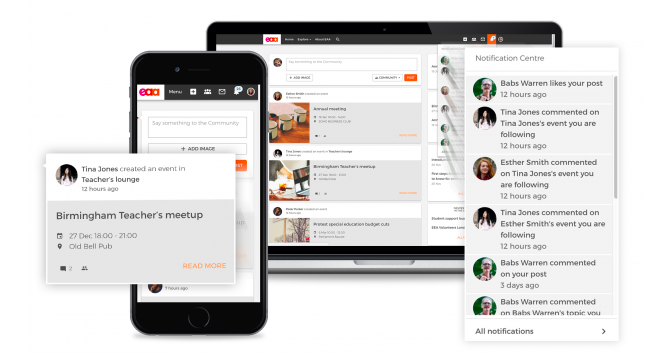Working on big and intricate projects often require organizations the need to build an intranet system which can be used as a focal point for internal communication as well as between the client and the company, with a strong architecture and easier management required.
Popular as a CMS, Drupal is capable of document and asset management as well. Already successful as a community platform, it can also be used as an intranet to facilitate the smooth working of a project.
In this blog, we have outlined why and how Drupal is the best fit for an intranet and if it can actually fix the problems faced due to poor intranets.
Ugly intranets are everywhere, regardless of software or solution.
Getting to Know your Intranet
In the era of collaborations and mergers, businesses are looking for ideas and solutions on a sharing basis. While reflecting on the scope of sharing, the internal teams play a significant role.
Given then collaborations are the way forward, intranet solutions are the solution to businesses and organizations for sharing ideas too. For co-workers to easily communicate and execute agendas together, the intranet serves as a great bridge. With core features and administration of the highest potential on offer, the Intranet brings the common shared goal of the teams in a closed and systematic manner.
Drupal is one of the open source CMS that provides out-of-the-box user and content management for your intranet to thrive.
Drupal 8 is a snug fit for the next generation of Intranets. Not only is it object-oriented and built with industry-standard libraries, but its organization and powerful API allow it to scale to the demands of massive growth and infrastructure requirements. Previously impossible requirements, such as supporting teams of hundreds of simultaneous developers and integrations, are now built into the Drupal way of thinking. Drupal 8 makes it easy for teams to asynchronously deploy features, tools, and content across your entire Intranet. It allows responsive teams to be their best and build sites and organization that is ready for both mobile access and full desktop experiences.
Common Challenges With Intranet
- More than often organizations overcrowd the stack of Intranet with every new technology added.
- The probability of duplicate content can pose issues for the employees while accessing the information
- There are minimal or no features to encourage the user collaborations on the Intranet
- The intranet is not yet mobile-friendly
- The lack of personalization on the intranet becomes an issue for the departments and local offices.
- The process of the intranet can seem to be burdensome for the teams to monitor without customization
Solutions With Drupal
- Drupal has an extraordinary ability to plug technologies like Apache Solr and modules like Google Search Appliance that can perform the search across thousands of Intranet pages.
- For the problem of duplicate content, Drupal comes with the ability to refine user roles. The easy to publish content and search-friendly option displays the latest information across the site.
- Drupal provides the option to personalize the content for user engagement and experience. Features like bookmarking, detecting user IP address, and location display allows you to extract better information.
- Drupal is known for its mobile-first capabilities. It provides a platform for a responsive intranet with the latest Drupal 8 functionalities.
- Drupal’s core collaboration modules enhance the social business experience for the user
- Being an open source, integration is the easiest part for Drupal with any third-party platform.
- The CMS has high configurable abilities for the content and file management features for the asset management of your intranet
One of the fastest and safest platforms, Drupal upholds its community-built modules. They require little or no programming for the integration and you are good to go!
Some More Characteristics of Drupal For Intranet
While we know the obvious functionalities of Drupal being high on security and user-friendly, here a few more feathers in the cap to be mentioned:
-
Quicker Turnaround Time
Even if launching your own intranet is a last-minute idea, Drupal still has things sorted for you. Distributions are the best option in the given case.
Along with a pre-configured installation which has default Intranet features such as groups, activity streams, commenting, and a customizable user interface, Drupal distributions like Open Atrium, Open Social, and Drupal Commons are a great way to quickly install one intranet for the organization.

Moreover, because Drupal’s architecture is based on the concept of “overrides,” these Distributions can be further enhanced with the custom backend or frontend features without compromising the default features they’re packaged with. With this, it would make sense to start building an Intranet application with a Distribution.
Providing features like a group, and case management out-of-the-box, Open Atrium is a popular choice for building intranet systems with Drupal. An intranet is built for operational transparency, to monitor tasks which are in the pipeline and their respective progress levels. In Drupal, you can monitor projects, milestones, and deliverables on the go and have full control over the projects and teams.
-
Easier Management
Intranet systems are used to deliver collaboration tools in order to facilitate engagement, expedite CRM tools, and ease project management, all to improve productivity. Since there would be a considerable size of people using the intranet (within an organization), there arises a need for easier and customizable workflow.
In Drupal, one can easily create “permission settings” by creating various user roles in order to avoid any chaos and confusion. Presenting an enhanced user role and management criteria, the feature can be improved by adding single sign-on capability using a couple of modules. Creating roles is as easy as writing any blog.
Drupal facilitates information, documentation with easy administration. Drupal is fully fit for document and resource administration.
In the absence of an intranet system, everything is a nightmare.
It is important to keep track of the user activities when the number of people involved in the project is more. Drupal’s out-of-the-box content versioning feature automatically saves new versions of content that can be easily rolled back if needed.
Modules like Diff module provide a more granular view and better grip of any text and/or field values that change from one version of content to the next.
Media module solves the management of external media asset libraries and for a defined publishing workflow a smooth access control is required. The Workbench suite can be utilized for the same purpose.
Modules like LDAP or CAS provide a single sign-on capability for user management tasks
Social media modules for activities like microblogging (Statuses), and networking (Flag Follow, Flag Friend). Also, there are modules like Advanced Forum, Comment and Privatemsg for content interaction.
Apache Solr is a module that supports searching on Solr and can be expanded upon with the Search API module
-
Flexible Enough To Integrate
Because the main purpose of an intranet is to share the information, processes, and resources among employees and clients, the intranet system will require features according to the needs of the project. Features that might be missing in the default. What do you do?
As mentioned before, Drupal facilitates collaboration and works on the concept “overrides,” where a feature can be further enhanced with customization.
Integration is an easier step than coding from scratch. Drupal provides the flexibility to integrate with various modules, custom codes, established software, and tools like Account management system, SharePoint, Google Docs, SAP, and Sugar CRM. Since Open Atrium comes with six features - a blog, a wiki, a calendar, a to-do list, a shoutbox, and a dashboard to manage it all, integration can best save the time. Integration with third-party tools is possible only because of Drupal’s modular and scalable architecture.
With the concept of API first (popular with Drupal 8), the possibilities to use Drupal to expose content via JSON and XML are almost limitless. Full and progressive decoupling not only allows applications to be integrated well when it comes to third-party integrations Drupal also allows easy theming and customization.
-
Zero Licensing Fees
Above all, Drupal is a free software. New features, updates, or upgrades will not send you to the “pricing tier”. No recurring licensing fee is asked since the open source innovations keep the community working together to create, improve, and extend functionality. With this, you have the control of who’s working on your project.
Out-of-the-box user management, better collaboration features, and easier content management make Drupal a natural fit for use as an Intranet. Other than this, it has modules and distributions offering the organization an ability to create an experience which is rich in social and visual engagement.
It can also effortlessly integrates with third-party tools wherever the need arises. By far, Drupal is apt to build an Intranet customized to meet unique user and management needs.
Drupal Site + Drupal Intranet
While we have established enough trust in the intranet built with Drupal, it’s imperative that having your site on Drupal adds the fuel of efficiency. Here’s how:
- The resources are already equipped with the know-how of Drupal and the integration becomes a smooth journey.
- With the site on Drupal, consistency can be maintained with the experience and performance of the intranet and the processes get seamless for the users
- The user management capabilities get manifold as the modules are highly supportive and extensive with the main site.
Connect with us at [email protected] to give your organization the right tools to facilitate project management, with remote collaboration and ease of communication.
Subscribe
Related Blogs
Inside the Drupal AI Summit: Themes, Speaker and What To Expect

“ The web is changing fast, and AI is rewriting the rules. It writes content, builds pages, and answers questions directly,…
FOST and Drupal AI Initiative: Next Era of Responsible AI

Three years after the launch of generative AI tools marked a new age for artificial intelligence, almost 90% of survey…
Drupal AI Ecosystem Part 5: AI Content Suggestions

Drupal has steadily evolved from being just a content management system into a flexible platform that incorporates emerging…




